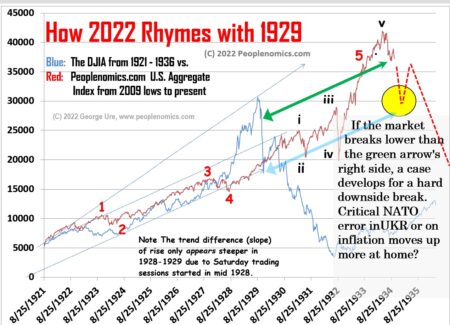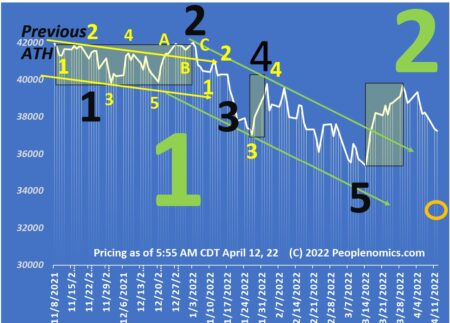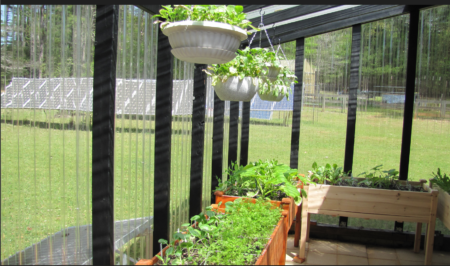Glimpse into dying link: Glimpses of afterlife? ‘Near-death’ experiences aren’t hallucinations, scientists conclude – Brain Tomorrow
Three visuals to help visualizing a few econ points.
First is a long-term, 10+ year chart. One trace shows 1920-1933 while the other is from the 2009 Housing Bubble low to close of trading Tuesday 4/22/22. This is an “Aggregate Index” – meaning equal dollars in the Dow stocks, the S&P 500, and the NASDAQ Composite:

This is NOT financial advice. However, it IS useful and interesting.
When we zoom-in on the extreme right side of the present day track, we can see a decline from highs set November 8, 2021:

As of showtime overnight, futures were pointing to a rally the open Wednesday, but some of that may depend on data being released in the morning. The Producer Price Index will offer some insight into the state of inflation back up the manufacturing pipeline a ways.
Thursday (tomorrow) the other big number to watch will be retail sales. It’s OK for prices to rise, but if the product of unit volumes times sales begins to fall, it will offer an increased likelihood of a Q3 recesssion.
On Food
Here’s a snapshot of the food-growing room we added onto the side of our sound room at our place in the woods.
What makes this room interesting is the construction technique which is very recycle-friendly. The foundation, for example, is not poured concrete. Instead, it’s a fairly recent technology called “ground screws” that I did a write-up on last November when the odds of extreme rising prices and possible food shortages by the end of 2022 first “popped” on our radar.

The construction highlights are:
- Ground screws topped with 4X4’s for the foundation.
- Sections of cementitious board (dug in 6″) screwed to the vertical face of the 4X4’s.
- Treated 2X4’s (8 foot for the verticals, 10’s for the rafters
- Sheet corrugated Lexan over.
- A few sacks of sand and 12X12 patio pavers for the floor.
- Swamp cooler and filter ground level air intake, outflow high and screened at the far end.
- Rainwater collection and stand-alone 12V marine pressure pump and solar to ensure water under all foreseeable conditions.
The cost of adding this room was on the order of $1,500 and time less than four 5-hour days. With a finished interior of 190 square feet, $7.89 per square foot but with no labor included. (We had planned to be around and breathing, anyway…)
Enjoy the show!
George@Ure.net

One of the nice things about living three hours beyond the left coast… George Noory is on my local station at 8pm Hawaiian Standard Time. I actually got your whole hour in before bedtime!
Living in EST time. Set a cassette recorder with auto-reverse and a C-120 for 1 am. (Yes, I still use cassettes — appropriate technology for simple applications.)
Haven’t played it yet, but will a bit later when the “Country Morning” brush fires are all extinguished…
Cassette machine? An old Radio Scrap “Dual Donsel” model duplicator with two drives, and an auto-reverse. Got some Maxell NOS C-120s. Perfect for the mission.
– 73 –
“(Yes, I still use cassettes — appropriate technology for simple applications.)”
Wow.. like 8Track and Beta.. I didn’t think they still made them.. I am surprised though.. they still sell the C-41 chem’s Kodachrome still has one plant open in Kansas.. I believe it is the same plant we use to send Disk film to back in the day LOL.. amazing.. we use to do three thousand plus rolls of kodachrome a day.. now you can still buy the film but only one processor..
I was amazed.. I tried out a camera at a photo shop I use to manage the lab.. they have a machine now that takes the digital image converts it to a negative and projects it to the paper.. amazing piece of equipment.. so when you get your photo you can either get a nice printed one or a regular photo processed one.. I did get a tickle.. a control strip I did in the late seventies and early eighties is still on the wall where I hung it way back then LOL..
I tried out one of the new camera’s.. was able to focus on my grand daughters cornea and get the image of what was on the shelf behind me.. pretty nice.. great lens.. as good as any leica lens.. funny to.. my child hood dream was to be the next ansel adams.. do a lot of nature photography.. etc.. and today the extent of my photographic skills is on the phone or a cheap fifty dollar digital LOL…. there is a trippy old abandoned house I want to do pictures of.. get a pretty model and make some really nice black and white.. yes I am a sucker for black and white LOL.. good filters.. those were the good old days for sure..
reminiscing..
https://youtu.be/XBETVhHpcPk
LooB wrote:
“my child hood dream was to be the next ansel adams.. do a lot of nature photography.. etc..”
About 5 to 7 years ago I had to do a late drop at the local Fed Ex facility just before the last overnight was to leave (11 pm ish) and started talking to the guy behind the counter. Ended up he was a photographer who couldn’t make money at it anymore … ala his working the Fed Ex late counter shift.
More interesting was his history. Back in the late 1960’s early 1970’s he went down to Tucson and started working with Ansel Adams who finished out his life and career with his studio in Tucson. The guy I was talking to went all over the place with Ansel as Ansel taught him all about light /composure /and darkroom, things beyond just the normal photography stuff that any good photographer knows and can do. He was with Ansel for about 7 years as I recall him saying. Couldn’t say enough good things about the man and his generosity towards him … and about how much he learned from him by working beside him for those years.
VOILA …
*Radio killed Vaudville as being king of the live entertainment hill
*TV killed Radio as being king of the live entertainment hill
*Internet killed the coffee table mass magazines as well as the weekly news magazines and the daily newspapers for conveying news and for all sorts of other information.
Suddenly the ability to sell “photographs” to news organizations and to magazines for enough money to make a living DISAPPEARED, and disappeared almost overnight.
Combined with the new digital cameras everybody and their brother could now take pictures, and many were willing to sign their rights over for almost free, or even free, just to have them published in one of the remaining publications that still published. (this was besides the public abandoning looking at print media almost entirely which reduced their circulation to a small fraction of what it had been, ie: number of eyeballs that would see a great photograph)
Voila … a GREAT photographer who was himself a potential Ansel Adams, who had been taught his graduate education in the photography by Andel Adams himself, had to go get a job working the late evening counter at Fed Ex.
I asked the guy if he still took pictures … and he said YES, for him it was an Art Form and as a artist he said he could not put down his lenses even if he couldn’t make money from them anymore. I then asked him if he still sold his work … and he mentioned that a couple of years before was his last real paying gig, did a photoshoot for a National Geographic article but other than that NADA.
I too thought about becoming a professional photographer … taught by the same guy who taught James Pickerell. Jim is a guy you probably never heard of but he had the 2nd highest number of covers of Life Magazine of any photographer ever. Many many National Geographic spreads.
Jim was not just brilliant photographer but an excellent combat photographer who managed to survive real combat in Vietnam for a number of years before he decided he had cheated death too many times and stopped going into combat with the troops.
Jim and I were both taught photography by the same guy, though many years apart. The person who taught it was an old shop teacher and he would only take on 3 students a year, but he made it into a multi year program so once you were in you did it and worked at it for years. For learning we used a 4×5 Graflex, only 2 film packs (4 pictures) allowed for most assignments. NO 24 or 36 picture rolls of 35mm allowed!! You HAD to get your assigned shots, and get a good ones with just those few pieces of film. As a result you were FORCED to compose your picture ahead of time, every detail in them, even for action shots, … since there were NO retakes in other words.
Well one day a couple of years into the program I was in the darkroom and reached above our rotary drum dryer and pulled down a stack of photographs had a zillion layers of dust on them, brushed off the dust and voila … these were pictures that Jim had done when he was the age I was then (mid teens) … and OMG the artistry in them was unbelievable.
By then I was a good photographer with a good artist’s eye and also a great technical photographer, but Jim’s compositions were on an entirely different plain. Both of us taught by the same guy using the exact same equipment executing the same assignments … but HIS ability doing those exact same assignments with those 4 or sometimes 6 shots, including action shots, were artisitcally clearly above my artistic ability.
When I graduated from HS I was offered a wonderful photography job with a multi location newspaper operation, making more money than paid to recent graduates from college journalism programs because of how good of a photographer I was, but I turned them down.
As I thought about the very financially rewarding offer I reflected on my ability compared to one of the greats in the photography field, Jim Pickerell. I decided then and there although I loved photography, and was very very good at it, better than anyone since Jim according to my instructor, and had a very good artist’s eye, I in no way compared to the World Class photographer that Jim Pickrell was.
If I couldn’t be in Jim’s league I didn’t want to go there, so my life went off in an entirely different direction. fwiw Jim was also a super nice guy, very insightful. He and my dad (ex State Dept) used to have great conversations about what was REALLY going on at the grass roots level of life in various foreign countries, since that is the level he worked at as a photographer. What an insightful person.
Like many my thousands of dollars of photography equipment now sits in a closet and would obviously need complete rebuilds to be used again, but for some reason I still can’t part with it though now I exclusively use lower mid range digital cameras, or sometimes just my cell phone camera, for taking pictures.
I still enjoy seeing a beautifully composed and perfectly exposed /printed photograph … for my artist’s eye they are a pleasure to revel in. Something that is very pleasing to my inneer soul.
Photography is an art that is disappearing from the public stage as Internet Video, versus still photography, becomes the medium of cateloguing and saving slices of our current life for future generations. I personally think it is a great loss though since a great photograph conveys much more information and emotional content than any moving picture of the same event /subject can.
I am sad to see the age of individual photograph Photography for informing us as to this world with it’s beauty, but also it’s daily trials and tribulations of life, departing from view. A very powerful medium for conveying infomation, important information, disappearing before our eyes. Never to return.
@Stephen 2
“About 5 to 7 years ago I had to do a late drop at the local Fed Ex facility…
…he was a photographer who couldn’t make money at it anymore … ”
‘Lotta that going around. I learned on an Argus. When the time came, I taught my daughter on a Minolta. She was the “camera girl” in High School. Her first two years she shot an old A1, but could use her Minolta when the Canon crapped out (which was thankfully most of the time.) Half-way through her Junior year, the school got DSLRs, so she got to use her Minolta digital (with my lenses), and she and the kid a year younger than she, were the last kids who learned how to frame, compose, expose, develop, run an enlarger, and what it meant to have to “get it right” without Photoshop…
I retired my cameras years ago. My daughter is in semi-retirement. It is impossible to compete with a “photographer” who goes to a wedding and takes 2000-6000 shots, then culls 97 percent because they’re garbage. She or I would take 96 shots, counting the informals, reception shots, and I would always push a 400×24 roll (Kodak made this marvelous Pro-400 which could be pushed to 6400) to shoot the {no flash allowed} ceremony itself. I took the same 96 shots once I started using a DSLR, although by that time, I was about done. No matter how carefully you frame and compose, brute force eventually beats artistry every time and the bride’s uncle’s cousin will shoot the ceremony for a couple six-packs.
Ahh, yes! The fond memories of photography abound. I still have the Nikkorex F with Soligor 135mm lens I used to take a headshot of Jack Ruby at one of his courtroom press conferences. Got me an ‘attaboy’ from UPI NY hq because my available light pic caught the tears running down his cheeks. Just a few months prior, I shot the only photo UPI had of JFK in the motorcade a few minutes before he was killed. My pic ran with the first UPI story about the assassination.
From there I moved on to industrial photography at Collins Radio, learning to use the Kodak 8X10 view cameras. The detail those 8X10 cameras could produce was amazing. I had to carry a camera case filled with camera and 10 – 12 film holders, heavy tripod, huge tungsten light and stand, and walk through Collins’ gigantic buildings to photograph the 11′ racks of equipment. Painting with light was the only way to get shadowless images required for technical publications. I was accused of practicing magic as I moved around the camera waving that huge light in big circles. Exposures were often up to 2 minutes.
When Dallas opened its first magnet school, I was invited to teach a commercial photography class there. I had two classes a day, 3 hours each, and the course was 2 years.
That gig lasted 16 years before I moved on to law enforcement. Same work as teaching in high school, but at least I was allowed to defend myself. The photography continued, but most of my subjects no longer needed to be posed, and the lighting was much less artistic. Corpses are not so vain as to complain that their eyes were closed in that photo. The transition to digital cameras at least eliminated the problem we had with deputies forgetting to rewind the film before opening the camera.
The evolution (or devolution) of photography from 8X10 view cameras to cell phones has been sad to watch. No longer will young photographers be inspecting an 8X10 negative with a loupe to be certain it’s sharp in all the corners. Now their only concern is for selfies on their phones.